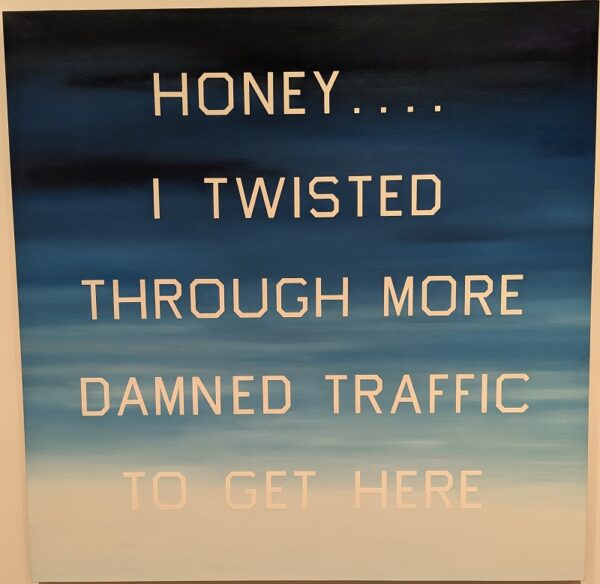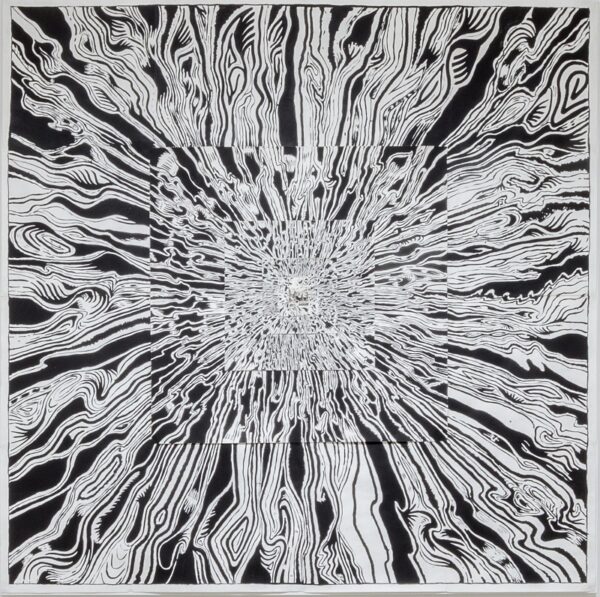Los Angeles is awash in modern art exhibitions about itself. The latest is Desire, Knowledge, and Hope (With Smog), at the Broad Museum downtown, with more than 60 works by 21 artists. It’s a fine survey ranging from Pop to abstract paintings, from politically charged posters to photography and ironic videos. Many of the works are from the 1980s, when L.A. art really hit the big time internationally.

The show is drawn entirely from the Broad’s permanent collection and includes several works never exhibited before. One of these, John Baldessari’s jaw-dropping Buildings=Guns=People: Desire, Knowledge, and Hope (With Smog) of 1985 (top image and above), gives the exhibition its name. This gigantic collage, about 37 by 15 feet, combines a group of dissimilar images that together tries to define the modern city that is Los Angeles.
On the left side there are couples kissing, and a bite taken from an apple; on the right is a huge blue rose. In the center is a bland high-rise building, flanked by a pair of enormous handguns and a dozen photos of people with their faces blotted out by white dots (a Baldessari trademark). It’s a lot to assimilate, but it suggests a city that can offer romance as well as violence, natural beauty as well as urban anonymity.
Baldessari (1931-2020) isn’t the most famous artist in the show — that would be Ed Ruscha — but he’s arguably the most influential. He taught generations of up-and-coming artists at California Institute of the Arts from 1970 to 1986 and then at UCLA until 2008, focusing more on the concepts behind an artwork than the techniques to produce it. His students included Barbara Kruger, Jack Goldstein, and Mike Kelley, all of whom are represented in the Broad’s show.

Several of Ruscha’s signature text-based paintings are on display, including 1984’s “Honey . . . I Twisted Through More Damn Traffic to Get Here,” a classic Los Angeles complaint. The words, in thin white sans-serif capital letters, are placed against a background of horizontal stripes that shifts from blue-black at the top of the canvas to almost white at the bottom. It could be an L.A. sky at dusk.
Ruscha’s works in the show include several other text paintings with head-scratching messages, such as Hollywood Is a Verb of 1979. And there are photo-realist paintings with equally ambiguous titles, such as Strong, Healthy of 1987, depicting two suburban houses in a leafy neighborhood. The scene is painted entirely in black and grays, except for two white windows and a large white horizontal band on each house, elements that look a lot like eyes and a mouth. What it means is hard to say.

Barbara Kruger is represented by an animated video, Untitled of 1987/2019, that literally deconstructs before your eyes. A large red box in the middle of the screen displays the words “I shop therefore I am” and seems to be held in place by an even larger gray hand. All of this appears to be printed on a jigsaw puzzle board that falls apart before your eyes, leaving a pile of pieces at the bottom of the screen. It’s a visually clever way to highlight the temporary satisfactions of consumer culture.

Robbie Conal’s poster Contradiction of 1987 features a roughly drawn portrait, like a woodcut, of then-President Ronald Reagan, with the word CONTRA above and DICTION underneath. The top word, of course, refers to the Iran-Contra scandal then bubbling through American politics, and the poster is a good example of the agit-prop style of Conal’s work.
The Contra affair involved the Reagan administration’s illegal transfer of arms to Iran in exchange for money and the release of hostages held by Hezbollah in Lebanon (sound familiar?). After that, the Reagan White House used the money to support right-wing Contra rebels fighting the left-wing government of Nicaragua. Other targets of Conal’s work include George H.W. Bush in It Can’t Happen Here, the Supreme Court in Freedom From Choice, and the disgraced tele-evangelists Jim and Tammy Faye Bakker in False Profit.

Amid all this Pop art and photorealism, Mike Kelley’s Infinite Expansion of 1983 is close to pure abstraction. Six square pieces of paper, each smaller than the one underneath and exactly centered on the same point, show an explosion of ribbon-like black streaks extending out to the edge of the painting. The meticulously crafted image evokes a number of ideas, ranging from the ordinary (a stone tossed into still water) to the profound (the universe a split-second after the Big Bang). Whatever it means, it’s a mesmerizing image.
Desire, Knowledge, and Hope (With Smog) runs through April 7, 2024, at the Broad Museum, 221 South Grand Avenue, Los Angeles.
More L.A. Art
For those who can’t get enough of these L.A. artists, just walk across the street to the Museum of Contemporary Art, which has mounted an excellent survey of the same era in Mapping an Art World: Los Angeles in the 1970s-80s. The show includes several of the same artists at the Broad – Ruscha, Baldessari, Kelley – as well as others such as the sculptors Robert Irwin and Claes Oldenberg and the photographers Judy Fiskin, Anthony Hernandez, and James Welling.
And there’s still more: Made in L.A.: Acts of Living at the Hammer Museum in Westwood surveys recent Southern California art, featuring more than 250 works by 39 artists. It’s the latest edition of the museum’s biennial surveys of L.A. art.
Mapping an Art World: Los Angeles in the 1970s-80s runs through March 10, 2024, at the Museum of Contemporary Art, 250 South Grand Avenue, Los Angeles. Made in L.A. 2023: Acts of Living runs through December 31 at the Hammer Museum, 10899 Wilshire Boulevard at Westwood Boulevard.
